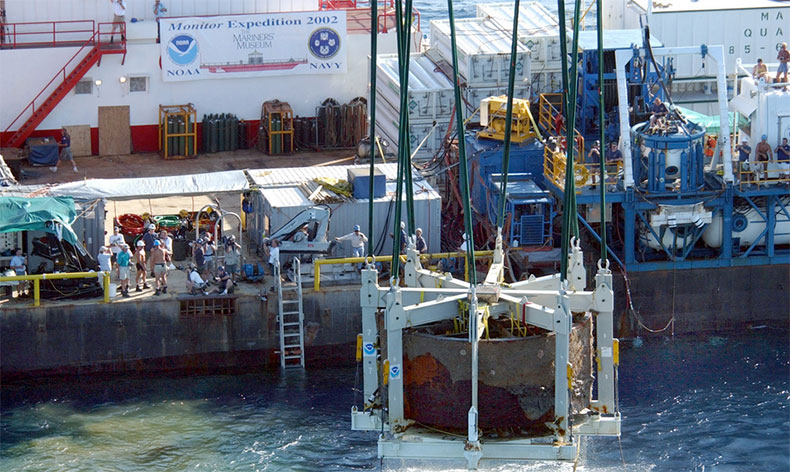
Response to Pressures
Responses to Pressures in Monitor Sanctuary
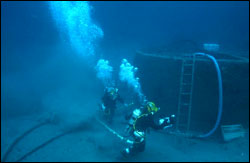
Monitor National Marine Sanctuary was specifically designated to protect and preserve the remains of the Monitor.Therefore, the Monitor sanctuary regulationsprohibit the removal and damage to any historical or cultural resource in the sanctuary. Sanctuary regulations also prohibit anchoring, stopping and drifting within the sanctuary; conducting salvage or recovery operations; using diving, dredging or wrecking devices; conducting underwater detonation; drilling in the seabed; laying cable; and trawling. Access is generally limited to scientific research conducted under a permit issued by NOAA; however, special-use permits are issued for non-research visits to this historic vessel.
Access to the wreck site is restricted to those with research and non-research permits. NOAA has issued a number of research permits since 1976 to private and public groups interested in conducting research on the Monitor in direct support of NOAA goals. Non-research permits have been issued since 1994 in response to requests by the technical diving community. Each private vessel that enters the sanctuary to conduct diving operations, whether for research or non-research purposes, is required to have a NOAA observer aboard. Enforcement of sanctuary regulations is led by the U.S. Coast Guard, with support from NOAA and guidance by the National Marine Fisheries Service (NMFS). NMFS and the Coast Guard hold annual briefings to assess enforcement efforts.
Enforcing sanctuary regulations is difficult given the Monitor’s remote location. The sanctuary does not have the resources to maintain a physical presence on-site. Therefore, sanctuary staff depends heavily on the watchful eyes of fishermen and dive operators, as well as patrolling efforts by the Coast Guard. Officers from NOAA Fisheries Office for Law Enforcement also help collect evidence and prosecute offenders, when necessary.
Additional enforcement is accomplished by educating potential user groups about sanctuary regulations and the resources they are designed to protect. By creating an understanding of the value and beauty of the sanctuary we hope to encourage voluntary compliance with sanctuary regulations. Education programs are a powerful tool, not only for enforcement of sanctuary regulations, but also for promoting an ocean conservation ethic among user groups. To date, education efforts have mainly focused on K-12 students, Civil War enthusiast groups, the general public and citizen groups via lectures, participation in community events and presentations at schools located in the sanctuary region. Expanded education efforts in North Carolina focusing on dive clubs and charter boat companies are currently underway.
The Monitor sanctuary is committed to providing educational programs and materials that teach about the history, discovery, recovery, conservation and wreck site of the USS Monitor. One of the best ways to learn about the Monitor is to visit The Mariners’ Museum in Newport News, Va. The museum and NOAA have brought the story of this unique ironclad to the public through the dramatic USS MonitorCenter. The center serves as the primary visitor center for the Monitor sanctuary,and tells the story of the Monitor through a rich array of original artifacts, archival materials, immersive multimedia experiences, a full-scale external replica of the vessel, and recreated ship interiors that transport visitors back in time to 1862. The opening of the USS Monitor Center represented a major milestone for NOAA’s Maritime Heritage Program as well as education and outreach efforts for the program.
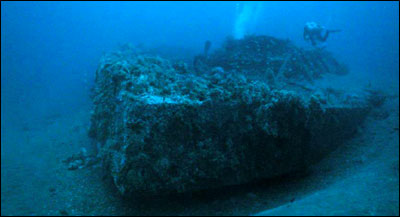
Recreational and Commercial Fishing
Monitor National Marine Sanctuary’s regulations prohibit activities that could impact the wreck or alter the sanctuary’s existing biological habitats or disturb and damage its natural resources. Recreational and commercial fishing are potential stressors to marine species and the site of the Monitor. Therefore, the sanctuary prohibits anchoring without a permit within its boundaries. Other activities such as discharging waste material into the water, detonation of explosive material, seabed drilling, seabed cable-laying, and dredging are also prohibited within the sanctuary’s boundaries. Each violation can result in civil penalties of $50,000. Prohibition of commercial fishing (other than those types of commercial fishing that do not pose a threat to the site, such as live-boating sport charter fishing) and trawling in the sanctuary helps to eliminate the pressure of fishing gear on the living resources and integrity of the wreck.Diving and Artifact Recovery
Site looting poses a major threat to submerged archaeological resources. The diving community must be educated on proper wreck diving etiquette and the regulations in place in order to protect these non-renewable resources. Diving inMonitor National Marine Sanctuary requires a permit and high technical skill as the site of the historic ironclad is 230 feet deep and influenced by strong currents typical of the Graveyard of the Atlantic off Hatteras, N.C. In 2007, the Monitorsanctuary was visited by 35 scuba divers and one private diving expedition. Special use or research permits are required for dives in the sanctuary.The sanctuary program works hard to balance access to the site with resource protection, and will continue to work diligently to provide a system of access to the wreck for divers wherever possible as long as protection of the wreck site can be assured. In the future, Monitor National Marine Sanctuary staff will continue to work to find additional ways to increase the number of divers who visit the site on an annual basis. Resource protection will always be a priority with regard to site access so the wreck may be preserved for future generations of historians, researchers and divers.
Research
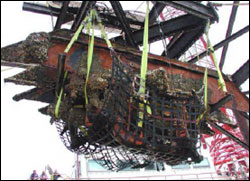
Since 1977, research at the Monitor site has focused on documenting the wreck in detail and understanding how it has been affected by natural deterioration and human activities. Because research itself may result in harm to the resource, or increase the risk of harm, all research conducted at theMonitor site is subject to the sanctuary’s permit regulations.
Research activities within the Monitorsanctuary have focused on documenting the wreck and surrounding site in detail to obtain a better understanding of the ship itself and to monitor deterioration of the habitat attributed to natural deterioration and human-related activities. All research and diving activities that take place within the sanctuary must be approved by the sanctuary in the form of special use or research permits. NOAA's Maritime Heritage Program, committed to preserving historical, cultural and archaeological resources within the National Marine Sanctuaries, is a leader in these research efforts.
The Monitor sanctuary’s long-term goal is to coordinate scientific research and monitoring of the ecological conditions of the sanctuary. This will allow staff to track and compare natural and human-caused changes in habitat and living resources, including the impacts of invasive species on the condition of the sanctuary and the Monitor.
Archaeological research will continue to be the main focus of the Monitor sanctuary. The majority of the wreck site is still unexcavated. Future expeditions will continue to document the wreck site for deterioration related to natural and human activities. Additional archaeological recoveries will document gaps in the details of the Monitor’s construction and provide a better understanding of the social environment aboard the novel 19th-century warship, giving insight into the ship’s stores, tools and personal items used by the officers and crew.
The University of North Carolina at Chapel Hill (UNC) has been collecting data on water quality off Cape Hatteras for several years. Considering the proximity of theMonitor sanctuary to the area of UNC research, the existing data may be applicable to the sanctuary’s waters. A partnership with UNC could be a starting point to establish the Monitor sanctuary’s own water quality monitoring plan in the near future. Parameters of particular interest include currents, temperature, salinity and pH, all of which affect deterioration rates of artifacts, as well as living resource conditions.
Natural Deterioration
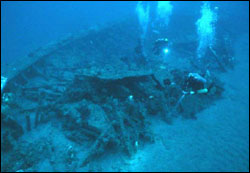
The Monitor will continue to deteriorate due to the natural process of corrosion. It is believed that with proper management the wreck will remain for centuries, as we have seen on other shipwrecks. Sanctuary staff are working to reduce disturbance of the site as much as possible and limit access to the site to individuals with a legitimate research design and those who are specifically trained to dive on wrecks without disruption. Additionally, NOAA is exploring the impact of placing cathodic protection on the wreck site to further reduce the corrosion rate.

